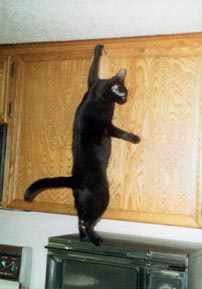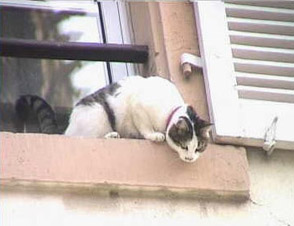Feline Home Safety
Since many of us believe that a house is not a home without a cat, we need to ask ourselves if our home is a safe place for them. If you have children, many of the safety measures needed for cats are probably already in place. If not, then it is necessary to look around the house and fix potential hazards.
Even cats that spend most of their time indoors may be exposed to a number of potential hazards. Disinfectants, drain cleaners, and detergents are among the many household chemicals that are toxic to your pet. They should be stored in tightly closed containers and secured cabinets where pets are unable to reach them. Medicines should also be stored out of reach.

Sharp objects such as knives and forks, carpet tacks and pins should be kept out of reach. Children's toys and small objects may attract a playful kitty and become lodged in its mouth or swallowed. Although kittens are sometimes pictured with a ball of yarn, a playful kitten and yarn are a bad combination. If ingested, yarn, as well as any kind of thread, twine or ribbon could cause serious damage to the esophagus and intestinal tract.
According to the National Safety Council, as many as 5,000 house fires a year can be attributed to pets as a result of their chewing of electrical cords. In order to prevent this hazard, do your best to keep electrical wiring out of your cat's sight and reach. Exposed lamp cords and other wires should be kept as short as possible. If extension cords are used, tack them against a baseboard or run them under a carpet so they cannot be played with or chewed.
If you live in an apartment, your cat may be vulnerable to “high-rise syndrome”. If your window screens are not securely fastened, a cat may fall from a window and suffer serious injuries or even death. A cat should be sufficiently restrained or confined if allowed on an apartment balcony.

According to the Center for Disease Control, 74 percent of homes in the United States built prior to 1980 contain hazardous amounts of lead paint. As with humans, any item containing lead can be extremely harmful to a cat. Harmful effects may not show up until weeks after ingestion. Signs of lead poisoning include vomiting, diarrhea or constipation, loss of appetite, loss of muscle coordination, blindness, and seizures. Consult your veterinarian immediately if you think there is a possibility of lead poisoning.
In addition to indoor dangers, outdoor hazards are often found in the garage or shed. Harmful products include windshield cleaners, weed killers, insecticides, used motor oil and antifreeze. Many cats are attracted to the sweet taste of antifreeze (believe it or not!) containing the chemical ethylene glycol, which is highly toxic to cats. If it is spilled on the ground or leaking from your car, it can combine with a puddle, making it exceptionally easy for your cat to drink it. New antifreeze products have been introduced that claim to be non-toxic to pets, but it's always better to be safe than sorry. Be sure to clean up spills of any questionable liquid to avoid injuring your kitty!
Wherever the hazard may come, it is important to remember that your cat is not so different from a child. Curious paws and noses may inevitably discover areas that have yet to be "kitty-proofed". Once you get to know the likes and dislikes of your cat, it would be much easier to determine what is hazardous and what has not made your cat's priority list of noteworthy attractions.
[ Search Articles ] [ Article Index ] [ Previous Page ]